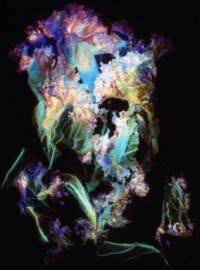Man Ray (1890-1976) was an American artist and prominent participant in the Dada and Surrealism art movements.
Although Ray worked in a wide range of mediums including painting, drawing, found-objects assembly and film, he is arguably best known for his photographs.
One of his most famous photographs (as well as one of my favorites) is Le Violon d'Ingres (Ingres's Violin).

Gelatin silver print
© Man Ray Trust ARS-ADAGP
Source: http://www.getty.edu
In the early 1920s, in France, Man Ray taught himself the camera-less photographic process photo-gramming. He named the products of those darkroom adventures, Rayographs.
Although Man Ray had by no means invented the process, biographer Neil Baldwin described what set Rayographs apart from the work of previous photogram founders:
"[In the darkroom, Man Ray] punctuated the plane of the paper, dispelled whatever impression of flat imagery remained, and veered into unplotted spatial territory, making light an instrument as subtle as the brush had once been in his hands."
- Neil Baldwin, Man Ray, American Artist

The Fan
by Man Ray
More than 60 years after the first Rayograph was created, I was exposed to Man Ray's work while studying photography at a fine art college in Philadelphia in the mid-1980s. I appreciated the full body of Ray's work, but his photography made the greatest impression on me. It was experimental — sometimes naughty, even — and it announced that there was something more available to the artist in the darkroom. Mastering the techniques of producing photographic prints wasn't all work. There was adventure to be had!

Natalie Sehn Weber, 19xx
In the early 90s, I worked at custom photo lab in the evenings. Working on the evening shift had its benefits. Occasionally, I'd finish my day's workload while the lab remained open, its huge color print processing machines still humming. On those nights, I'd "punch off the clock" and disappear into a darkroom, free to play with color light-sensitive materials. The final product: a color alternative to Rayographs and, with a tip of my hat to Man Ray, I named the images Natagrams.
To learn more about Man Ray’s Rayographs, view Museum of Modern Art’s multimedia presentation.

